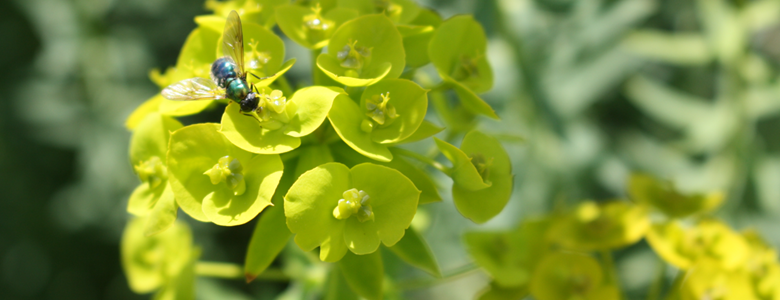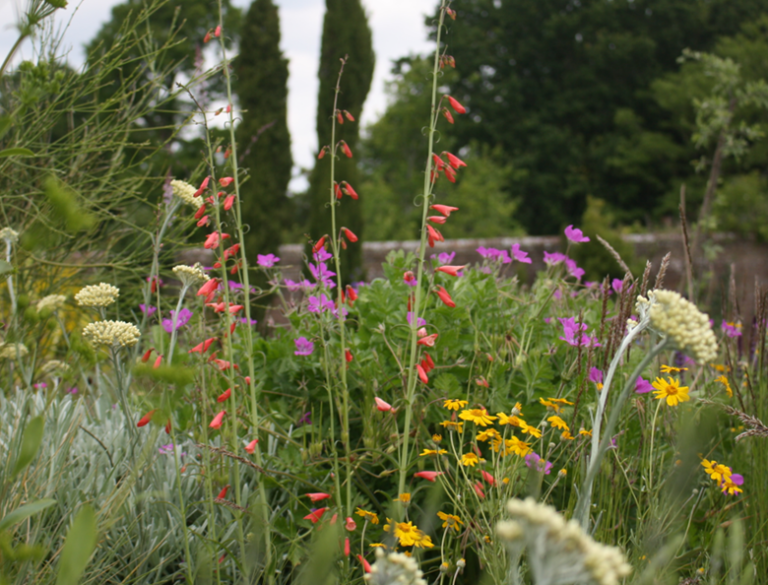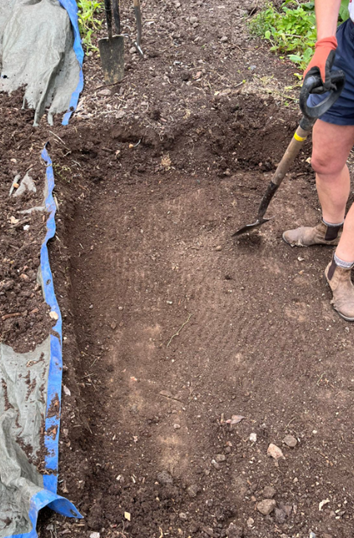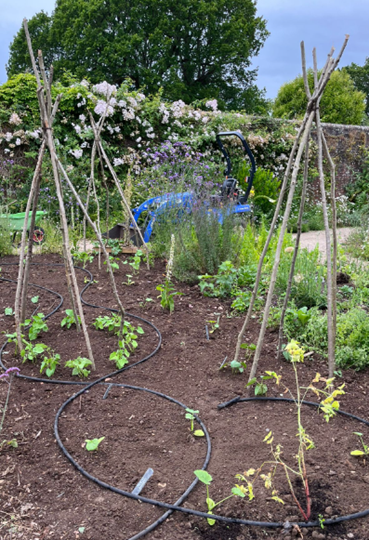
The Journey to Wilding the Garden
June 2024
On the first day of June the garden opens its gates as part of the National Garden Scheme – a charity supporting health and nursing since 1928, where 3,500 private gardens all over the country invite the public to share their green spaces through the year. 2023 saw them raise an impressive £3.4 million.
A rare sun appears on the day, and it’s a refreshing pleasure for us to be in the garden as observers rather than curators and appreciate the diversity of flowers and colours along with our 150 visitors. This year, the third season since the planting of the Rewilded Garden, we can begin to see the flux of winners and losers in a self-willed garden where natural processes guide how the garden develops. The native spreading bellflower (Campanula patula) has dispersed itself throughout the mounds and hollows of the sand and crushed concrete with abandon, numbering over a hundred plants from the original stock of twenty-five small specimens in a limited area by the pool. The same can be said of the nine species of beardtongues – with the southwestern, prairie, egg-leaf and large penstemons (Penstemon barbatus ‘Coccineus’, P. cobaea, P. ovatus and P. grandiflorus), originally over-sown in a seed mix confined to James Hitchmough’s ridge having jumped the paths and comfortably settled in the rest of the garden from last year’s seed heads we left standing.

The red bell flowers of the southwestern beardtongue (Penstemon barbatus ‘Coccineus’)
The foxtail lilies (Eremurus himalaicus) that had punctuated the ridge with their 1.5 metre-long, brush-like, white flowerhead the first year after we’d planted them are, sadly, some of the losers this year. Perhaps this is partly due to the relentless wet weather but the increase in the surrounding vegetation may also have contributed to their disappearance. Their natural habitat of semi-desert and dry grassland is difficult to mimic, and with their strange fleshy, shallow roots resembling an octopus they resent both overcrowding and disturbance, a natural consequence of all the self-seeding plants in the Rewilded Garden.
As for the winners, we’re excited to see the compass plant (Silphium laciniatum) – a North American prairie native – sending up an erect stem for the first time. It takes its common name from the thick, sharply-lobed leaves orienting themselves in a northsouth direction. It’s very good for pollinators, provides seeds for birds through winter, and when mature can produce up to 100 large, yellow, sunflower-like flowers. Some gardeners treat it with caution, it being slow-growing and long-lived (reputedly a hundred years) with deep tap roots – it has been noted to become difficult to eradicate once established. We’re hoping to benefit from the roots of these plants to help with drainage, drilling into some of the areas that have been compacted when the ground was first sculpted by the landscaping contractors between late 2020 and the summer of 2021.
Compaction is often a problem when using heavy machinery such as diggers and dumper trucks to reshape a garden, particularly on soil such as Knepp’s. The heavy Wealden clay running 320 metres beneath us is as dense as wet plasticene in winter and hard as concrete in summer. Despite the varying depths and mixes of aggregate laid on top, we suspect an impermeable pan has formed underneath the surface in some areas, allowing water to pool, making it difficult for plants to access nutrients and possibly creating anaerobic conditions. When roots not adapted to wet conditions are deprived of air they essentially drown.
A compounding factor is the sheer amount of rain we’ve had over the past seven months, with consistently lower-than-average temperatures, giving very little chance for the soil to dry out. In these conditions, nutrients and minerals are leached out of the soil faster than they can be manufactured by the soil biota. The outward signs manifest as yellowing leaves, particularly on woody shrubs and trees, susceptibility to fungal, viral or bacterial infections, and slow growth in perennials and annuals.
In the Kitchen Garden the vegetables in the no-dig beds had been showing similar signs. Despite using winter cover crops and home-made compost, and experimenting with different methods of irrigation, the organic content of the top 10cm of the soil was either too wet or too dry and not supporting healthy soil biota. The broad beans and leeks were suffering, and salads were bolting prematurely. Understanding the complexity of microorganisms in the soil and promoting them more effectively and, in particular, improving our own compost, is something we are slowly working on. We’re sampling the soil regularly and watching for signs of nutrient deficiency, but it is a complex business. When Suzi and Charlie cleared the top 30cm of soil of one section of the vegetable beds they discovered, to their dismay, a solid layer of compaction. They resorted to breaking it up with pickaxes and added leafmould and loam to try to improve drainage and allow easier passage for those incredible keystone species of the soil, anecic earthworms. From the Greek meaning ‘out of the earth’, these earthworms burrow vertically in the soil. By feeding on leaves and other organic matter on the earth’s surface and excreting the digested material down in their tunnels, up to 3m in depth, they make nutrients – notably nitrogen and phosphorus – readily available to plants, as well as improving the aeration and drainage of the soil itself and providing favourable conditions for other soil organisms. Having replaced the soil, Suzi planted out the runner beans and squashes she’d brought on in pots, and we’ll watch and closely monitor the results of their labours.


Left: Suzi uncovers a compacted pan Right: The replaced soil with climbing beans and squashes
In the Rewilded Garden, the solutions to compaction are a little more complicated. Most of the plants are now established and it is difficult to clear a large area of small trees and perennials with the same ease as a bed of annual rotating crops in the Kitchen Garden. We reached out to our Advisory Board, forwarding to them some suggestions we thought had potential. These included stripping surface aggregate and plants and ‘deep-ripping’ the clay beneath with a mechanical digger; using a robin dagger (a probe that injects compressed air in four directions 50cms below surface level); mounding up an area using recycled aggregate from the estate and replanting or simply leaving the plants, hoping they will adapt over time. Tom Stuart-Smith, the garden’s designer, suggested a mix of approaches in different areas, favouring the use of a deep tine and adding smaller aggregates before replanting. We know that the long, free-draining ridge that has the highest density of crushed concrete to the greatest depth favours James Hitchmough’s choice of plants. Many plants in Tom’s design hail from the same kind of habitats around the world – dry stony riverbeds or prairie deserts that would benefit from a deeper aggregate mulch. We’ll wait for some dry days in autumn to undertake this kind of work. As gardeners we need to be careful to choose a time when a plant is going into dormancy before moving it. But at the same time, at Knepp, we need to remind ourselves that this is a garden experiment where we’re replacing the animals that drive a dynamic landscape. As agents of disturbance, it’s important to let go of ‘protecting’ an image in the garden and embrace change as a natural process, even if that means we may lose some plants. We don’t want to be too precious and controlling. After all, compaction happens in nature too. So we’ll leave some of the areas without intervention, just as the animals moving through the rewilding project interact with the landscape in random ways.
It’s not until the summer solstice, when the sun momentarily rests on the belt of the earth and shares the longest hours of light with us, that the jet stream retreats along with the rain. Finally, we can shed our sweaters and embrace the heat and sunshine as the thermometer climbs to 30°C. The garden seems to respond immediately. Even the Buddleia, those hardiest of shrubs, have stopped sulking and begun to flower. Their lilac and purple cones join the bright yellows of the spurges, Spanish broom, evening primrose, king’s spear and St John’s wort with the vivid fuchsia colours of Manescau storksbill and Carthusian pink. Summer has begun.
Moy Fierheller Deputy Head Gardener June 2024
Photos courtesy of Karen Finley, Charlie Harpur
What we’re reading;
nutrient absorption Archives – John Kempf
Charles Darwin, The Formation of Vegetable Mould Through the Action of Worms, pub. John Murray, London 1881